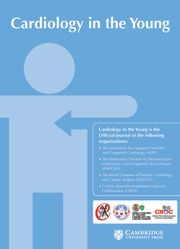Article contents
Serum-soluble suppression of tumourigenicity-2 as a biomarker in children with congestive heart failure
Published online by Cambridge University Press: 13 March 2023
Abstract
We aimed to evaluate serum soluble suppression of tumorigenicity-2 in children with congestive heart failure, to assess the diagnostic and prognostic values of soluble suppression of tumorigenicity-2 in these patients, and to correlate its levels with various clinical and echocardiographic data.
We included 60 children with congestive heart failure as the patient group. Sixty healthy children of matched age and sex served as the control group. Patients were evaluated clinically and by echocardiography. Serum level of suppression of tumorigenicity-2 was measured for patients at admission. All patients were followed up for death or readmission for a period of one year.
Soluble suppression of tumorigenicity-2 was significantly higher in children with congestive heart failure as compared to the control group. Soluble suppression of tumorigenicity-2 was significantly increased in patients with higher severity of congestive heart failure. There was a significant increase in soluble suppression of tumorigenicity-2 in patients with bad prognosis compared to those with good prognosis. There was a significant positive correlation between soluble suppression of tumorigenicity-2 and respiratory rate, heart rate, and clinical stage of congenital heart failure, while there was a significant negative correlation between soluble suppression of tumorigenicity-2 and left ventricular systolic and diastolic function. The best cut-off of soluble suppression of tumorigenicity-2 to diagnose congestive heart failure was > 3.6 with 87% sensitivity and 79% specificity. The cut-off point of soluble suppression of tumorigenicity-2 to diagnose congestive heart failure in children was ≥ 31.56 ng/ml, with 95% sensitivity and 91.37% specificity. Moreover, the cut-off point of soluble suppression of tumorigenicity-2 to predict bad prognosis in children with congestive heart failure was ≥ 255.5 ng/ml, with 92% sensitivity and 89.0% specificity.
Soluble suppression of tumorigenicity-2 is a good diagnostic and predictive biomarker in children with congestive heart failure.
Information
- Type
- Original Article
- Information
- Copyright
- © The Author(s), 2023. Published by Cambridge University Press
References
- 1
- Cited by


